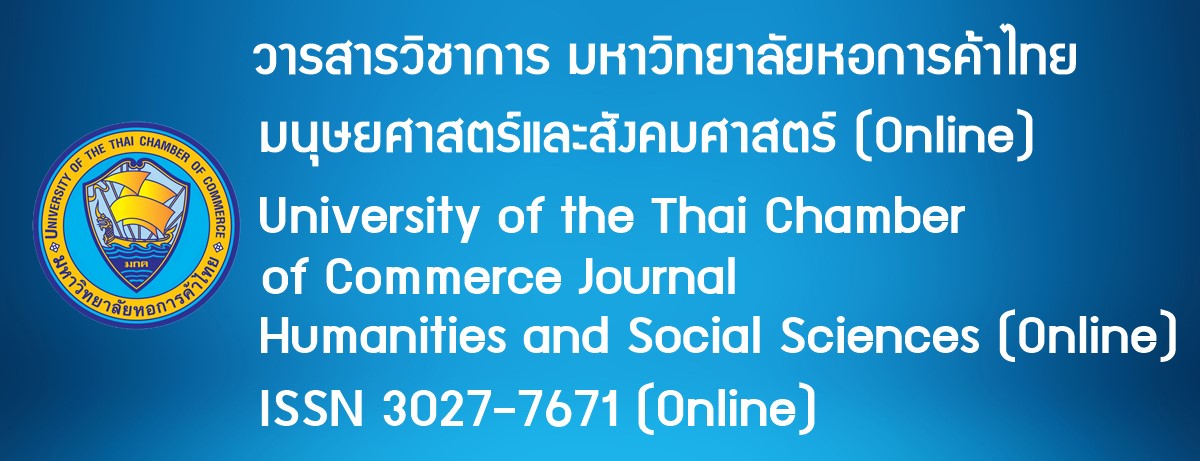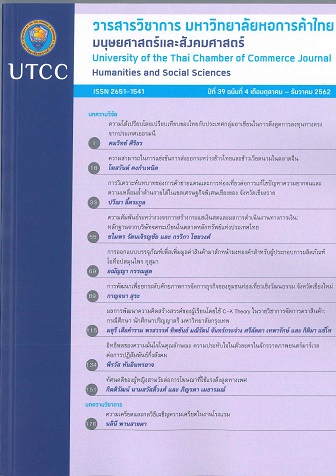ผลการพัฒนาความคิดสร้างสรรค์ของผู้เรียนโดยใช้ C-K Theory ในรายวิชาการจัดการตราสินค้า: กรณีศึกษา นักศึกษาปริญญาตรี มหาวิทยาลัยกรุงเทพ
Main Article Content
บทคัดย่อ
งานวิจัยนี้มุ่งศึกษาการพัฒนาความคิดสร้างสรรค์มีวัตถุประสงค์ 2 ข้อ 1) เพื่อเปรียบเทียบความคิดสร้างสรรค์ เอกลักษณ์บทบาทเชิงสร้างสรรค์ และการรับรู้ความสามารถทางความคิดสร้างสรรค์ของนักศึกษาก่อนและหลังการจัดกิจกรรมโดยใช้ C-K Theory และ 2) ศึกษาอิทธิพลของพัฒนาการเอกลักษณ์บทบาทเชิงสร้างสรรค์และการรับรู้ความสามารถทางความคิดสร้างสรรค์ต่อพัฒนาการความคิดสร้างสรรค์ของนักศึกษา วิธีดำเนินการวิจัยเป็นการวิจัยกึ่งทดลองแบบกลุ่มเดียวมีการทดสอบก่อนและหลังการทดลอง ประชากรที่ศึกษา คือ นักศึกษาปริญญาตรี มหาวิทยาลัยกรุงเทพที่ลงทะเบียนเรียนในวิชาการจัดการตราสินค้า ภาคการศึกษาที่ 2 ปีการศึกษา 2560 จำนวน 628 คน สุ่มกลุ่ม (cluster sampling) ห้องเรียนและคัดเลือกตัวอย่างที่มีข้อมูลครบถ้วนได้จำนวน 53 คน เครื่องมือที่ใช้ในการวิจัย ประกอบด้วย แบบวัดเอกลักษณ์บทบาทเชิงสร้างสรรค์จำนวน 4 ข้อ แบบวัดการรับรู้ความสามารถทางความคิดสร้างสรรค์จำนวน 6 ข้อ และแบบวัดความคิดสร้างสรรค์ตามแนวคิด Torrance 4 ด้าน ประกอบด้วย ความคิดคล่องแคล่ว ความคิดริเริ่ม ความคิดยืดหยุ่น และความคิดละเอียดลออ สถิติที่ใช้วิเคราะห์ ได้แก่ ค่าสถิติบรรยาย การทดสอบทีแบบไม่เป็นอิสระ การคำนวณคะแนนพัฒนาการ และการวิเคราะห์ถดถอยแบบพหุ ผลการวิจัยพบว่า ความคิดสร้างสรรค์ด้านความคิดริเริ่มและการรับรู้ความสามารถทางความคิดสร้างสรรค์เพิ่มขึ้นภายหลังการจัดกิจกรรมโดยใช้ C-K Theory และพัฒนาการเอกลักษณ์บทบาทเชิงสร้างสรรค์มีผลต่อพัฒนาการความคิดสร้างสรรค์
Article Details
ลิขสิทธิ์ของบทความ
ผลงานที่ได้รับการตีพิมพ์ถือเป็นลิขสิทธิ์ของมหาวิทยาลัยหอการค้าไทย ห้ามมิให้นำเนื้อหา ทัศนะ หรือข้อคิดเห็นใด ๆ ของผลงานไปทำซ้ำ ดัดแปลง หรือเผยแพร่ ไม่ว่าทั้งหมดหรือบางส่วนโดยไม่ได้รับอนุญาตเป็นลายลักษณ์อักษรจากมหาวิทยาลัยหอการค้าไทยก่อน
References
ศิริชัย กาญจนวาสี. (2556). ทฤษฎีการทดสอบแบบดั้งเดิม. กรุงเทพฯ: จุฬาลงกรณ์มหาวิทยาลัย.
Barbot, B., Lubart, T. I., & Besançon, M. (2016). “Peaks, Slumps, and Bumps”: Individual differences in the development of creativity in children and adolescents. New Directions for Child and Adolescent Development, 2016(151), 33-45.
Cole, D. G., Sugioka, H. L., & YAMAGATA‐LYNCH, L. C. (1999). Supportive classroom environments for creativity in higher education. The Journal of Creative Behavior, 33(4), 277-293.
De Stobbeleir, K.M., Ashford, S.J., & Buyens, D. (2011). Self-regulation of creativity at work: The role of feedback seeking behavior in creative performance. Academy of Management Journal, 54(4), 811-32.
Farmer, S. M., & Tierney, P. (2017). Considering creative self-efficacy: Its current state and ideas for future inquiry. In M. Karwowski, & J. C. Kaufman (Eds.), The creative self: How our beliefs, self-efficacy, mindset, and identity impact our creativity (pp. 23-47). San Diego: Academic Press.
Farmer, S.M., Tierney, P., & Kung-McIntyre, K. (2003). Employee creativity in Taiwan: An application of role identity theory. Academy of Management Journal, 46(5), 618-30.
Gardner, H. (1993). Creating minds. New York, NY: Basic Books.
Grube, J., & Piliavin, J. (2000). Role identity, organizational experiences, and volunteer performance. Personality and Social Psychology Bulletin, 26: 1108 – 1119.
Hair, J. F., Black, B., Babin, B., Anderson, R. E., & Tatham, R.L. (2006). Multivariate data analysis (6 th ed.). Upper Saddle River, NJ: Pearson.
Hatchuel, A., Le Masson, P., & Weil, B. (2003). C-K Theory in practice: lessons from industrial applications. 8th International design conference, Dubrovnik. University of Zagreb.
Hatchuel, A., Le Masson, P., Weil, B., Agogué, M., Kazakçi, A., & Hooge, S. (2016). Multiple forms of applications and impacts of a design theory: 10 years of industrial applications of CK theory. In A. Chakrabarti, & U. Lindemann (Eds.), Impact of Design Research on Industrial Practice (pp. 189-208). New York: Springer International Publishing.
Holder, A., & Lovett, G. (2012). Learning from design creativity; Translating processes from practice to education. In A. Duffy, Y. Nagai, & T Taura (Eds). The 2nd International Conference on Design Creativity Volume 2 (pp. 92-98). Glasgow, Scotland.
Jaussi, K. S., Randel, A. E., & Dionne, S. D. (2007). I am, I think I can, and I do: The role of personal identity, self-efficacy, and cross-application of experiences in creativity at work. Creativity Research Journal, 19(2-3), 247-258.
Karwowski, M., Lebuda, I., Wisniewska, E., & Gralewski, J. (2013). Big five personality traits as the predictors of creative self‐efficacy and creative personal identity: Does gender matter?. The Journal of Creative Behavior, 47(3), 215-232.
Loudon, G., & Deininger, G. (2014). A new model for supporting creativity in research organisations. Proceedings of the R&D Management Conference. Fraunhofer IAO, IAT Universität Stuttgart.
McCall, G., & Simmons, J.L. (1978). Identities and interaction. New York: Free Press.
Oldham, G.R. & Cummings, A. (1996). Employee creativity: Personal and contextual factors at work. Academy of Management Journal, 39(3), 607-634.
Reich, Y., Hatchuel, A., Shai, O., & Subrahmanian, E. (2012). A theoretical analysis of creativity methods in engineering design: casting and improving ASIT within C–K theory. Journal of Engineering Design, 23(2), 137-158.
Shibuya,T., Seshimo,S., Harashima, Y., Kubota T., & Iba, T. (2013). Educational Patterns for Generative Participants: Designing for Creative Learning. In C. K. HAN (Chair). PLoP '13 Proceedings of the 20th Conference on Pattern Languages of Programs, Monticello, IL.
Sternberg, R. J. (2006). The nature of creativity. Creativity Research Journal, 18(1), 87-98.
Torrance, E. P. (1974). The torrance tests of creative thinking-norms-technical manual research edition-verbal tests, forms A and B- figural tests, forms A and B. Princeton, NJ: Personnel Press.
Torrance, E. P. (2008). Thinking creativity with words, forms A and B. Bensenville, IL: Scholastic Testing Service.
VandenBos, G.R. (2007). APA Dictionary of Psychology. Washington, DC: American Psychological Association,

